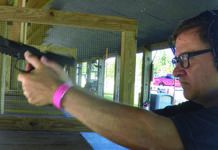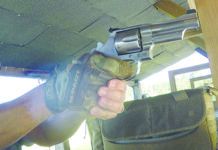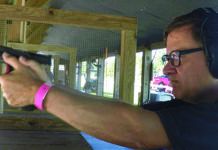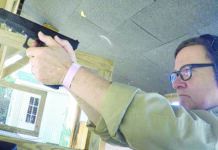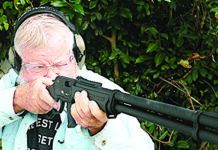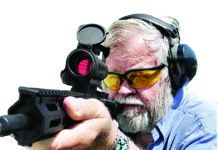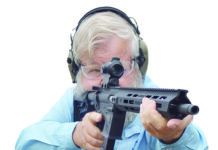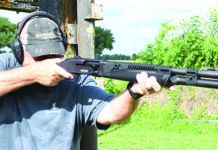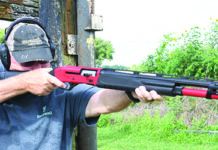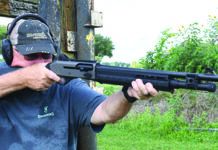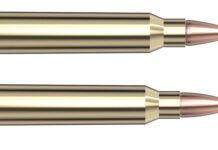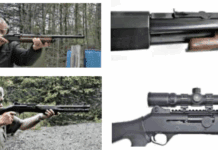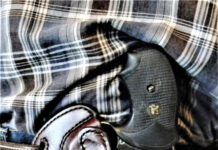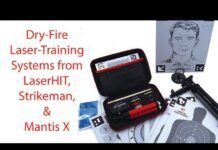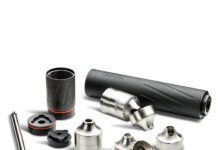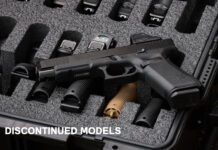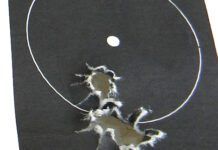There are certainly some aspects of the bullpup rifle that make sense. For instance, the shorter overall length of the bullpup, gained by having the action and magazine located behind the trigger in the buttstock, improves maneuverability and reduces weight. Overall, a bullpup is about three-quarters the length of other battle rifles and is often lighter, two attributes many firearms consumers want. The Steyr AUG, one of the best-known bullpups, is 28 inches long, just 10 inches longer than its 18.4-inch barrel. In a more conventional rifle, such as the Ruger Mini-Thirty, a standard semiauto action housing an 18-inch-long barrel makes the guns OAL 37.5 inches. On an M4-length AR-15, such as the Stag Arms Model 2T 5.56x45mm NATO with its 16-inch barrel, that overall length can still stretch out to 32.25 inches. So if youre worried about knocking over lamps, a bullpup may be the way to go.
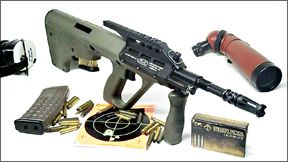
But which one? We recently tested a trio of bullpups that we were prepared to like because, in part, they are cool: the Steyr AUG/A3 SA USA Bullpup Rifle 5.56x45mm NATO-223 Remington, $2000, the U.S.-market semiauto version of the full-auto AUG; an AUG clone, the Microtech Small Arms Research (MSAR) STG-556 5.56x45mm NATO-223 Remington, $1750; and the non-AUG-inspired FN FS2000 Tactical 5.56x45mm NATO-223 Remington, $1995.
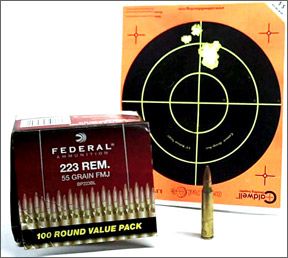
We got the lightly used MSAR and FN at Collectors Firearms in Houston (www.collectorsfirearms.com, [877] 214-9327), and the prices cited for them are what were on their hang tags. The FN and MSAR were both in “excellent condition” according to the Collectors descriptions. A new MSAR at Collectors ran $1895, and a “like new” FS2000 with its shipping box and other items was the same price as our FN test gun, $1995. Our Steyr was NIB, and we averaged five retail sources to arrive at the price we listed. In any case, we didnt assess any cosmetic downgrades on the two rentals because they werent new, nor did we award any advantages for the AUG because it came with a case and other items common to new guns.
In many respects, this test could be called AUG vs. FN, since the Steyr is the fraternal twin brother of the MSAR. Though all three are bullpups, they arrive at their work destination in two different ways. One of the problems with AUG-bullpups is, that without modification, the ejection ports would send spent cartridge casings into the face of a left-handed shooter. In contrast, the FS2000s design pushes spent casings out a port on the front of the rifle. But the bolt and ejection-port cover can be reversed in the AUG/MSAR, making them suitable for lefties.
How We Tested
We handled the guns in a series of static and dynamic tests, looking to contrast bullpup handling and performance versus a standard-length rifle, such as an SKS or AR-15. In particular, we wanted to see if the pups had too much weight in the butts, resulting in more muzzle rise and felt recoil. Another concern was reduced sight radius, which affects accuracy at longer distances. However, only the FN came with backup iron sights, so we used an Insight Tech MRDS compact optic for our 50-yard bench and 7-yard action tests.
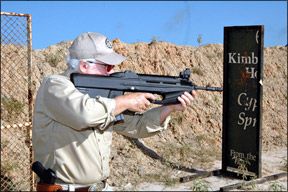
So that we had a baseline to compare the accuracy of the bullpups against two recommended AR-15s, we used two ammos from the January 2010 comparison of piston and DGI actions. They were the Monarch brand, which we bought for $5.99/20, or 30 cents a round. The Russian cartridges were 223-stamped FMJ ammo with lacquered steel cases and non-corrosive Berdan primers (www.ab.ru/~stanok). Next was a Federal Ammunition bulk pack, which cost $39.97/100, or 40 cents a round. It shoots a full-metal-jacket boattail bullet. Last, we shot a 62-grain 5.56x45mm cartridge from American Tactical, a brand made in Turkey and packed in 30-round boxes. The steel-core brass-cased boxer-primed reloadable ammo is manufactured by MKE in Turkey. This ammo has a sealed primer and an annealed case neck to meet NATO specs. Language on the box says it shoots under 1 MOA at 100 yards, but our guns didnt show that level of accuracy.
For accuracy testing, we shot all three guns off a Bench Master rifle rest ($125 from Brownells), using supplied magazines for the AUG (two 30-round polymer units) and one 30-round polymer and one 10-round polymer magazine for the MSAR. Because the FN will accept M16/AR-15 magazines, we shot it with 30-round steel magazines from Brownells ($20), and function tested it with three others.
Initially, we had a lot of problems with the AUG. While chronographing the Steyr, we recorded failures to fire on every other shot with the Federal and Monarch ammos, and failures to eject with the AT ammo. We traced the problem to one of the 30-round AUG magazines and began using the MSAR 10-rounder for accuracy testing. We had one additional FTF with the Monarch ammo in the Steyr after that, but we had no problems with the MSAR. We likewise didnt have any function problems with the FN using steel AR magazines, but we did find out where the front ejection port was when a hot casing dropped in between two fingers that were holding the front of the rest.
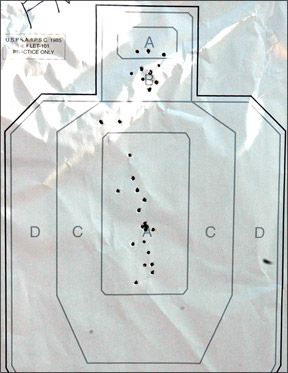
For the action portion of the test, we posted an IPSC-P target from www.letargets.com at 7 yards. The drill was to engage the target with two shots to the 5.9-by-11-inch rectangular A-zone at center mass, and then a third shot to the upper A-zone. The upper A-zone measured 4 inches wide by 2 inches tall. A perfect run is all hits inside the top and bottom A-zones. Start position had the shooter holding the dot about 4 inches below the center-mass A zone with the safety on. After ten runs we looked for 20 hits to the “chest” and 10 to the head. We kept track of elapsed time by using a shot-activated timer. For the action runs, we used the Federal bulk ammo exclusively, and once the bad Steyr mag was eliminated, we didnt have any malfunctions.
During our action tests, our shooters found that none of these guns can be babied. For instance, the triggers dont need to be slapped, but the press on all three should be aggressive without jerking. Same for racking the bolts and turning off the safeties.
But enough with the set-up. How about getting into the meat of these bullies to see if theyre right for you? Here we go:
FN FS2000 Tactical No. 3830000000
5.56x45mm NATO-223 Remington, $1995
Fabrique Nationale is located in Herstal, a suburb of Liege, Belgium. FN has a long and varied history in the firearms business. FN was instrumental in the design and standardization of NATOs 7.62x51mm and 5.56x45mm ammunition, and it makes many military weapons, such as the M249, M240, various 50-caliber machine guns, and the FAL light assault rifle. FN also manufactures the M16 assault rifle under license for the U.S. military. In the United States, FN is represented by two entities. FNH USA, located in McLean, Virginia, is responsible for sales, marketing, and business development with the U.S. military, government agencies, law enforcement, and the commercial sector. FN Manufacturing, located in Columbia, South Carolina, is the U.S. manufacturing arm of FN and is currently producing M16 rifles, M249 light machine guns, M240 medium machine guns, FN bolt-action rifles and FNP pistols.
The FN FS2000 Tactical is a semiauto-only carbine based on the FN F2000 Tactical bullpup design. It comes with a 17.4-inch civilian-legal barrel with a permanently attached flash suppressor. It first became available in June 2006. A variant of the FS2000, called the FS2000 Standard, is equipped with the factory F2000 1.6x magnification optic and sight cover.
Apparently, the Tactical version, like our all-black test unit with a polymer front handguard, is now available only in a bi-tone unit with O.D. green stock and lower and black upper and front handguard. The all-black Tactical unit (No.3835980040) has a front-rail in place of the polymer handguard. But there are plenty of FS2000 black units like our test gun out there, if youre not an ODG fan. Our lightly used test gun didnt come with a full package of new-gun items like the Steyr, but we didnt penalize the FN for that. A new FS2000 ships in a blue cardboard container, and comes with one 30-round magazine, the owners manual, and a lock. A fitted soft case (No. 3830624, about $190 retail) is also available
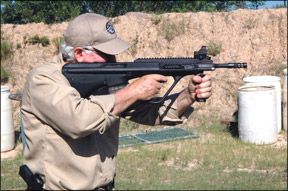
separately, as are FN magazines (about $65 for the 10-round and $55 for the 30-round).
Two primary patents cover the FNs operational system, one from October 1997 (Ren Predazzer) and the second from February 2000 (Charles Denuit). The F2000 ejects spent cartridge casings forward and to the right side of the weapon through a tube running alongside the barrel. After empty casings are extracted, they are fed onto a shelf located in a cavity in the receiver wall, which then directs it into a tube. Located above the barrel, the ejection tube is more than a foot in length, so the first few rounds arent ejected until the tube is full and the ejection port door is forced open. If the operator wants to clear the tube quickly, he tips the muzzle down and all the casings in the tube will fall out.
The gas-operated system utilizes a rotating bolt lock-up and fires a variety of 5.56x45mm ammunition fed from M16-style metal or aluminum magazines. Plastic or polymer magazines should not be used, according to FN. The gun measures 29.3 inches in overall length, with 17.4 inches of that being the 1:7-inch-twist barrel, which has a chromed bore. The gun comes with a 10-in. MIL-STD 1913 top rail optic rail along with backup iron sights. The rear flip-up National Match-sized aperture is adjustable for windage, while the removable front sight is adjustable for elevation. Maximum sight radius is 10.9 inches. Because of the matte-black synthetic stocks depth, the top rail, and the length of 30-round mags, the gun is tall, having an overall height with iron sights of 10.2 inches and an overall height with the MRDS of 11.0 inches. The stock has a 15.0-inch length of pull and a maximum thickness of 3.2 inches, which occurs at the top of the buttstock, measured across the charging handle.
Gun-only weight (without a mag or optics) was 7.9 pounds, and its “ready” weight with a loaded 30-round steel Brownells mag and MRDS was 9.2 pounds. If we bought this gun, wed be sure to buy some 10-round mags, since the 30s make shooting off most standard-height benchrests difficult. As noted, the semi-automatic gas-operated action fires from a closed rotary bolt with a short-stroke piston system and a two-position gas regulator, which we shot on “normal.” The receiver is matte-black anodized alloy with a rear-hinged polymer cover that pops up to allow inspection of the chamber. Our sample didnt come with a front rail, but the polymer handguard can be replaced with an aluminum-alloy accessory fore-end that provides three MIL-STD 1913 forward mounting rails (No. FN3830500, about $190).
One of the big advantages the FN showed in our test was that by ejecting cases to the front, the FS2000 allows shooting by switch-hitters or left-handers without modifications. Accordingly, the magazine catch and fire/safety selector are under the gun and ambidextrous. Also, the ambidexterity allowed us to put on a laser and simulate shooting (with snap caps) around corners with either hand while staying behind cover. The other two guns didnt afford this option, since theyre set up to eject on one side or the other.
To charge the gun, the shooter pops in a magazine underneath the gun, then retracts and releases the handle on the left side of the gun, stripping a round from the magazine and ramming into the chamber. Theoretically, its possible to make a reload without ever taking the gun down in any position, but we had some problems. The magazine release is a big grooved button unit in front of the magazine well. During our testing, we found AR-15 magazines dont pop out like they do on M4s, and the mags need to be pulled out of the well. Inserting a mag blindly is almost as difficult because the well is underneath the gun and close to the shooters body, and you cant use your peripheral vision to help find the insertion slot, our testers said. Also, the bolt does not does not stay open after the last round is fired, so that slows down reloads a bit, too.
On the upside, the deep well means that magazines dont protrude as much as on a typical carbine and have less chance of snagging on bushes, doors, or whatever else you might encounter. And all the controls are within reach of even small-frame shooters and work well by feel. The rotating safety is on the trigger and is easily manipulated by the trigger finger.
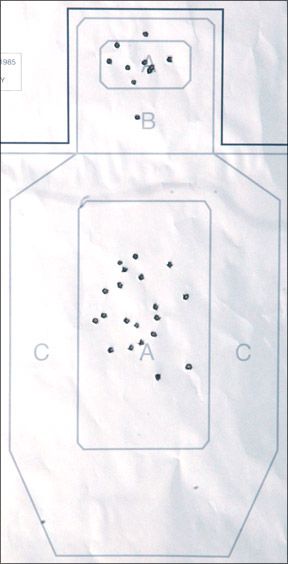
The receiver fully encloses the operating mechanism, giving very reliable functioning in adverse conditions. And the use of polymers in the shell makes the FN resistant to corrosion. Visual verification of the chamber condition is performed by flipping up a hinged inspection port at the rear of the receiver. Our testers said it was hard to peer into the action to see if a round was chambered, and the thin-plastic ejection port cover might get broken if it were open during rough handling, which we admit is unlikely.
The cocking handle is placed on the left side of the receiver, just above the handguard. There are no access points for the possible ingress of dirt or debris; the cocking handle slot is sealed.
During initial administrative handling of the gun, our testers liked the snappy action and quick release of the charging handle. One of the odd sensations of shooting the FN was its mismatch of visual bulk and weight. The gun felt lighter than it looked, which is a good thing, but our testers also noted that the gun wasnt easily grasped except through the thumbhold stock. The thinner top profiles of the AUG/MSAR or of an AR give the shooter a couple of places to grab the gun from the top and go. Thats a little harder to do with the FN, we thought.
Elsewhere, we had problems with the FS2000, some nit-picky and others more substantial. We didnt enjoy shooting the FN off the rest because its height, rounded forearm, and thumbhole stock made getting a comfortable position more difficult than with the AUG/MSAR. We read some FS2000 owner comments in online forums, some of which said “the trigger is a crisp single stage,” that it felt like “a 10-pound Glock-like” trigger pull, and that “it isnt that bad,” and that the “break is crisp.” That wasnt true on our gun. The pull was mushy and indistinct, and during accuracy testing, we simply started to pull the trigger and kept pulling until the gun went off. At 50 yards, this made a small but noticeable difference. In the 10-shot average group radius measurement, the FN came in 2nd behind the MSAR with the Federal 55-grain FMJs (0.50 in., MSAR; 0.81 in., FN; 0.99 in., AUG), third in AGR with the American Tactical 5.56x45mm 62-gr. FMJs (0.83 in., MSAR; 0.94 in., AUG; 1.09 in., FN), and third with the Monarch 223 Rem. 55-gr. FMJBT (0.89 in., AUG; 1.00 in., MSAR; 1.09 in., FN). Also, we give FN credit for providing iron sights-something the AUG/MSAR lacked-but the rear flip aperture isnt stout, and the system is rudimentary, we thought. FN says the sights are backups, and we think thats accurate.
The barrel features a four-port birdcage-type flash hider that has a closed bottom and an angled cut at the tip, which FN says directs the muzzle blast upward, compensating for muzzle rise. We didnt notice undue rise one way or the other with any of the guns. We did experience the feeling of “hearing” the actions work via vibrations sent through our cheekbones. This is a bullpup design issue, and we didnt much like the sensation on any of the guns.Our Team Said: We understand there are lots of bullpup adherents out there, but most of our testers arent among them. We recognize the value of the short OAL of the FN FS2000 and the others, but were hard pressed to recommend that you spend around $2000 for a gun, unless you have CQB needs in your home or truck. But if you just gotta have one of these bullpups, wed put the FS2000 behind the AUG and MSAR on the basis of cost, accuracy, and ergonomics.
STEYR AUG/A3 SA USA Bullpup Rifle
5.56x45mm NATO-223 Rem., $2000
Steyr Mannlicher GmbH & Co, the 140-year-old firearms company, makes its home in Steyr, Austria. The Armee Universal Gewehr (Universal Army Assault Rifle) was adopted by the Austrian Army as the StG 77 (Sturmgewehr 77) in 1977, replacing the much older and heavier StG 58. Since 2007, the A3s USA investment-cast aluminum receiver and steel barrel have been made in the United
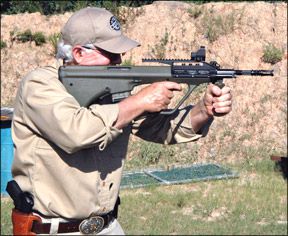
States by Sabre Defence Industries.
The standard AUG-A3 SA is the 16-inch carbine, though two other commercial barrel lengths are available: 20 and 21.6 inches, all of which had eight lugs that lock into a steel insert in the alloy receiver. Up front, a 10-port brake was threaded to the muzzle of the 16-inch tube. Also, the gas-piston-operated AUG/A3 included a bolt hold-open/release lever, a top-mounted Picatinny rail, and a short rail on the receivers right side. The barrel can be changed out by passing it through a channel in the top of the receivers triangular cross section. Theres also a folding vertical fore-grip and a gas regulator with two settings: one for normal use and a high setting allowing more gas flow when the rifle is dirty. The AUG-A3 comes standard with two 30-round clear-plastic magazines, a logo-stiched soft carry case, factory AUG sling, and a cleaning kit that fits in the buttstock.
The AUGs overall length was 28.2 inches, the bulk of which was the barrel, which with its flash hider measured 18.4 inches in length. The AUG came without sights, the supposition being that with the 10-inch MIL-STD 1913 top rail and 2-inch side rail, the user would likely supply optics of his choice. Ours was the MRDS, which made the overall height with a magazine 12.1 inches. LOP was 15.0 inches, and the maximum thickness across the charging handle at the top of the rubber butt was 3.0 inches. Stripped of mag and optics, the bare gun weighed 8.15 pounds, and a loaded (30 rounds) and sighted AUG tipped the scales at 9.6 pounds. The black fiberglass-reinforced polyamide stock and front folding grip had a light texture for better gripping. The safety was a two-position lateral push-through design with an extremely sharp rear left edge. The trigger broke at 10.1 pounds on the Lyman digital trigger gauge.
As we noted above, our testers had quite a few function problems with the AUG, which was surprising since the gun has a “run all the time” reputation. We believe we traced the problems to one of the two supplied magazines, but the experience troubled us.
At the range, our testers found the polymer charging handle on the receivers left side useful when retracting the bolt, and locking the handle against a notch in the receiver helped us clear the unfired rounds and internal feeding jams (such as one time when a live round in the chamber was prevented from extracting by a round in the magazine pushing up against the case). The handle also served as a forward assist. Another advantage of the operating handle being on the left side of the weapon is that it permits the shooter to manipulate the action with his non-firing hand while the rifle is still on his shoulder and shooting hand on the grip. To ensure we werent soft-setting the charging handle, which might cause the first round not to chamber properly, our testers started each magazine by either slapping the locked charging handle closed or by pressing in on the bolt hold-open release.
Elsewhere, we didnt see other mechanical problems. The safety was dumb-as-a-rock simple to operate: Press it to the right (flush) for Safe, exposing a white dot, or press it to the left for Fire‚ uncovering a red dot. The ambidextrous magazine release was a large lever at the rear center of the magazine well, and it dropped the waffled translucent polymer magazines free, unlike on the FN FS2000.
On the front of the gun, pull down on the vertical foregrip and it folds up and lays parallel to the barrel. From that position, pushing it forward unlocks it and allows the shooter to fold it down.
On top of the barrel, we effortlessly mounted the MRDS on the 10-inch section of 1913 rail, and on the right side of the lower receiver, we easily swapped out lasers and lights on the 2-inch section of rail-very handy, our testers said. Sling swivels are included on the left rear of the buttstock and just forward of the top rail. When a depression in the rubber buttpad is pushed, the rear sling-swivel stud can be pushed inward to release a catch on the buttpad, which
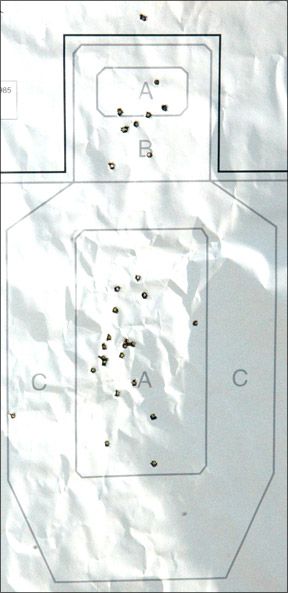
lifts off to allow access to a compartment for the cleaning kit.
With the laser in place, we snap-capped around corners with both hands to see if the AUG was as compact and easy to control as the FN. We found the AUG/MSAR permitted the operator to use his off-hand to manipulate doors while still keeping the rifle on shoulder. The FN also allowed this function, but with either hand because the AUG/MSARs ejection ports cant be swapped across mid-exercise.
Shooting live ammo at the range, we were disappointed with the AUG. Above, we noted the 10-shot average group radius measurements, in which the AUG failed to shoot the best with any of the test ammos. Looking at the maximum spreads (the distance between the two widest shots), the AUG was the worst with the Federals (1.23 in., MSAR; 2.07 in., FN; 2.70 in., AUG) and with the American Tactical FMJs (2.06 in., MSAR; 2.37 in., FN; 2.66 in., AUG) by fairly large amounts. However, it was nearly perfect in the action test, putting 28/30 shots in the appropriate zones (see page 11).Our Team Said: We know this will anger a lot of AUG-herents, but we just dont see what the big deal is. This gun is expensive, and our test gun gave us a lot of trouble that the others didnt. Also, our gun wasnt particularly accurate. However, it did far better in the action test, which its fans will note is the guns strength.
Microtech Small Arms Research (MSAR)
STG-556 Bullpup Rifle
5.56x45mm NATO-223 Remington, $1750
The “Microtech” in this guns name originates from Microtech Knives, Inc., whose president, Anthony Marifone, believed there was a market for a U.S.-made AUG-style rifle and decided to found Microtech Small Arms Research, Inc. (MSAR) to develop one.
Like the AUG, the STG-556 rifle is a gas-operated semiautomatic bullpup rifle featuring an interchangeable barrel. Other STG-556 features not found on the AUG originally included a forward assist (which has been discontinued at customers requests, but which appears on our test gun-see below), and a last-round bolt hold-open release. It also has a fluted barrel, a removable check nut, and tulip-shaped flash hider. MSAR tries to further distance itself from the AUGs foreign influences by noting that it uses only USA manufactured parts, material, and labor. Were not sure that the AUGs expensive cachet doesnt partially derive from its Austrian roots, but thats an issue for the individual shooter to decide.
The MSAR website makes clear that the company considers the gun to be a work in progress. For example, Marifone writes: “…many new weapons from reputable companies have had teething problems and recalls when they are first released, including the SIG 556 and the XCR. And I expect the Magpul Masada and FN SCAR will also have their own set of problems when released.”
But, MSAR seems to be responsive to customer wishes: “1. Elimination of the Bolt Forward Assist: Stocked STG-556 rifles manufactured after September 4, 2008 no longer feature the bolt forward assist. MSAR made the decision to eliminate the forward assist because of overwhelming customer requests for a STG-556 without the forward assist.”
And then this on the magazines: “2. Steyr AUG Magazine Compatibility: By popular request and in interest of standardizing Steyr-AUG and STG-556 magazines, STG stocks that no longer feature the bolt forward assist will also accept the Steyr-AUG magazines.”
Though there are many differences in the AUG and MSAR platforms, a close look at the specs for the two guns reveals their inherent similarities. The STG-556s overall length is 28.0 inches for the 16-inch-barrel unit. A slight variation is the 556s 1:8 twist, rather than the AUGs 1:9. Like the AUG, the MSAR didnt come with iron sights, but it was an inch shorter in height with the MRDS optic on board, 9.0 inches. LOP was the same at 15 inches, as was the maximum thickness, 3.0 inches. The naked MSAR was slightly lighter at 7.9 pounds and loaded with optics and a full 30-round magazine, 9.0 pounds. The MSAR came with 10- and 30-roundmagazines, and wed recommend the 10-rounders for bench work. The top rail was a 10-inch MIL-STD 1913, but there was no included side rail, though holes in the action would readily accept one.
MSAR offers a selection of barrel systems for the STG-556, including 14- (SBR), 16-, 20-inch versions cut with NATO-spec 5.56×45 mm chambers. The synthetic stock is made from high-grade polymer that is injection molded in two halves and then welded together. It incorporates two drain holes in the butt and three in the grip to let water out after the gun has been immersed.
In overall handling, our testers preferred the AUG/MSAR to the FS2K, mainly because of the front grips built into the first two, which allowed aggressive steering of the muzzle. The magazine well located behind the pistol grip features an ambidextrous paddle-release lever. We liked mag changes on the AUG/MSAR better than the FN, and the MSAR had an advantage over the AUG because of the last-shot hold-open release. The STG-556 employs an M16-style bolt hold-open/release lever above and to the rear of the magazine well on the left rear side of the stock assembly, and it always worked. While the AUG locked the action open on its empty magazines, its flat release lever didnt provide as good a feel as the MSARs L-shaped switch, our team said.
None of these bullpups had what our team considered to be a good trigger, and we were amazed to see dozens of owner comments online writing off this aspect of the bullpup design. For us, a good trigger is the third leg of the stool, along with reliability and accuracy. The STG-556 exhibited a heavy and creepy trigger pull, probably due to the long U-shaped trigger bar that actuates the rifles double-hook sear. But of this trio, the 11.1-pound MSAR trigger sucked the least, which translated into accuracy at the range. It shot the best with two of the three ammos (Federal and AT), and recorded an impressive best-of-test 0.50-inch AGR with the Federals, including an eight-shot cluster at 50 yards that a quarter would cover.
Our Team Said: We know that bullpuppers everywhere will criticize our skepticism about these guns, but were just not that enchanted with them. Theyre expensive, and they have some characteristics we dont like, such as indifferent accuracy (overall) and the feeling of too much rock-and-roll going on under the shooters cheek. Many of our testers said they would rather have an M4 with a great trigger and a collapsible stock (32.25 inches collapsed, only 4 inches longer than these guns) at half the price of a bullpup, no matter how cool the pups look.
But on these guns, our team was split. The AUG beat the MSAR in the action test, but the MSAR was much more accurate with our test ammos, and weve seen it selling for substantially less. The MSAR is the better value, we think, but if you really need a bullpup, you might like the AUG better.
0910-RIFLE-ACC-CHRONO-DATA.pdf



